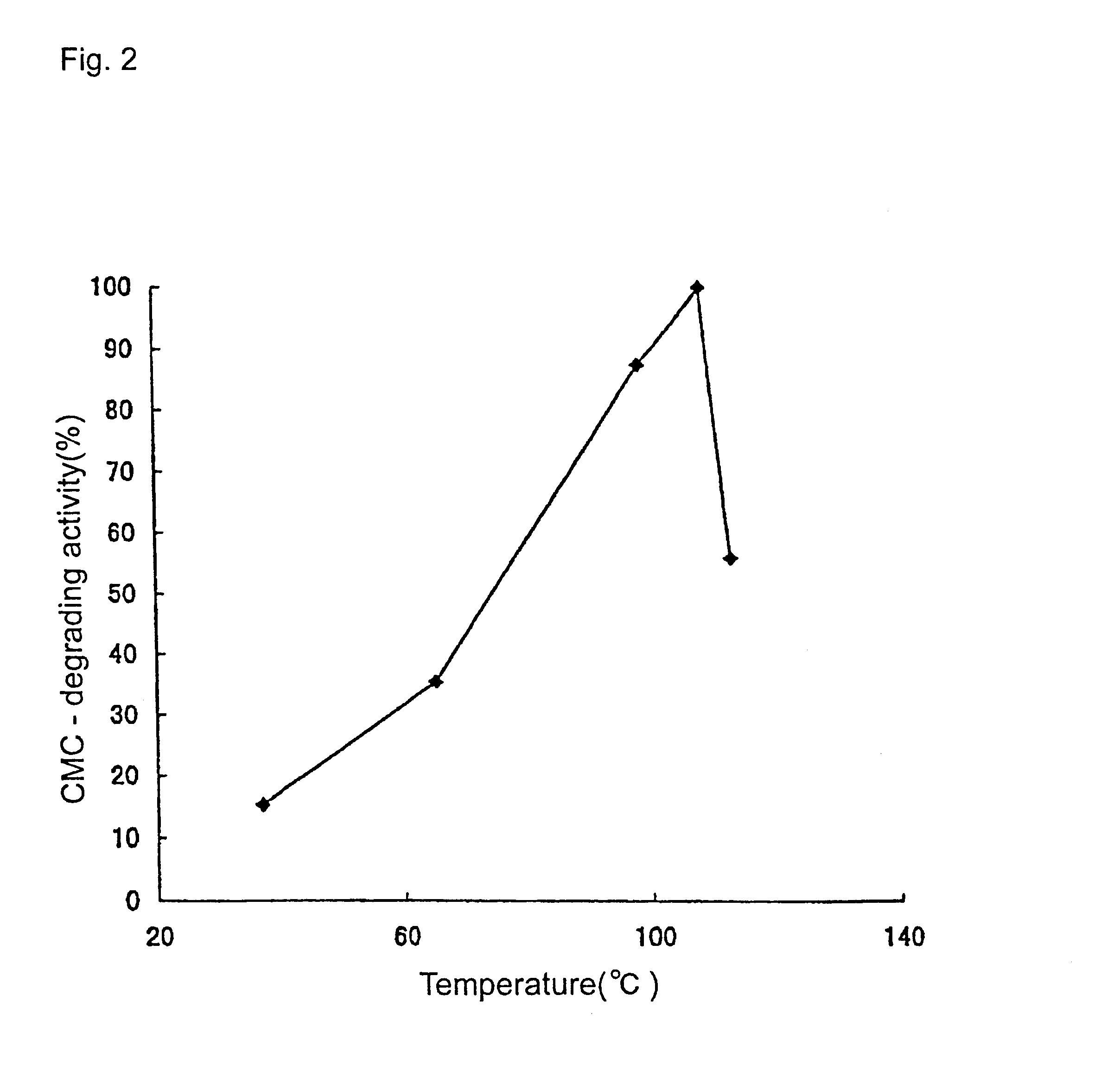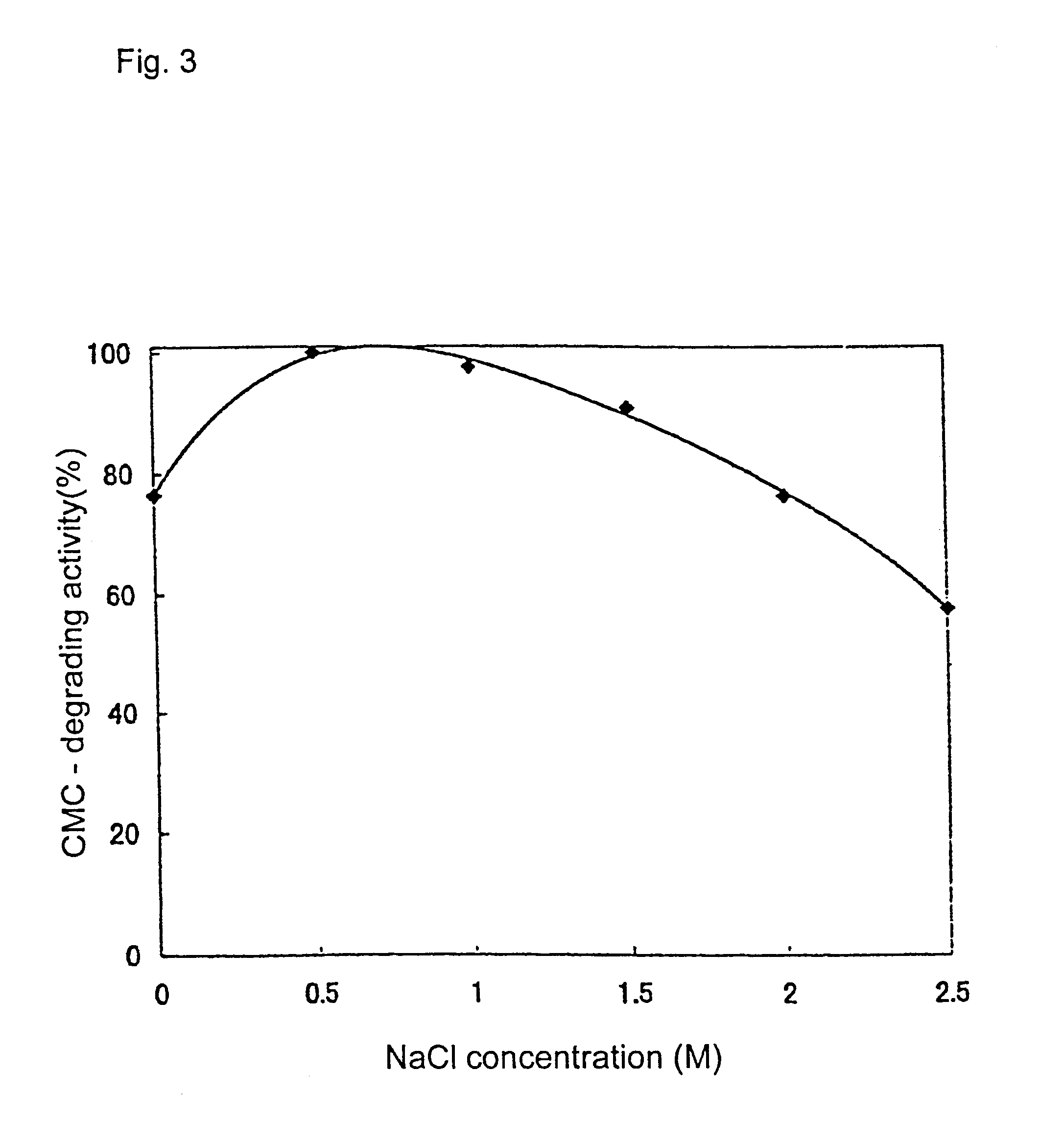Polypeptide having cellobiohydrolase activity
a polypeptide and activity technology, applied in the field of polypeptides with cellobiohydrolase activity, can solve the problems that the existence of an open reading frame having a homology with a nucleic acid encoding a known cellobiohydrolase has not been predicted, and achieves maximum cmc-degrading activity and maximal stability
- Summary
- Abstract
- Description
- Claims
- Application Information
AI Technical Summary
Benefits of technology
Problems solved by technology
Method used
Image
Examples
example 1
Construction of Recombinant DNA Containing Open Reading Frame PH1171 in Pyrococcus horikoshii OT3 Genome
(1) Preparation of DNA Containing Open Reading Frame PH1171
An oligonucleotide 1171FN having the nucleotide sequence of SEQ ID NO:3 and an oligonucleotide 1171RA having the nucleotide sequence of SEQ ID NO:4 were synthesized on the basis of the nucleotide sequence of Pyrococcus horikoshii OT3 genome in order to obtain an about 1.6-kb amplified DNA fragment containing the open reading frame PH1171 by a PCR using Pyrococcus horikoshii OT3 genomic DNA as a template.
Pyrococcus horikoshii OT3 JCM9974 (purchased from Riken) was cultured in a medium as described in JCM catalog (Riken) at 95.degree. C. for 16 hours. A genomic DNA was purified from the cultured cells.
A PCR was carried out using the oligonucleotides 1171FN and 1171RA as a primer pair and the above-mentioned genomic DNA as a template in order to obtain a DNA containing the open reading frame PH1171. The PCR was carried out ac...
example 2
Production of the Polypeptide of the Present Invention
(1) Expression of Polypeptide
pECEL211 prepared in Example 1 (3) or pET21d as a vector control was used to transform Escherichia coli BL21 (DE3) (Novagen). Each of the resulting transformants was separately inoculated into 5 ml of LB medium containing 100 .mu.g / ml of ampicillin, and cultured aerobically at 37.degree. C. overnight. The culture was inoculated into 5 ml of the same fresh medium at a concentration of 1%, and cultured aerobically at 37.degree. C. When the turbidity reached OD.sub.600 =0.4 to 0.7, isopropyl-.beta.-D-thiogalactopyranoside (IPTG, Takara Shuzo) was added at a final concentration of 1 mM. The cells were further cultured at 15.degree. C. overnight. After cultivation, the cells were collected by centrifugation, suspended in 0.5 ml of 100 mM sodium citrate buffer (pH 5.0) and disrupted by sonication. Supernatants recovered after centrifugation were used as cell-free extracts.
When cellulose is degraded using a ...
example 3
Physical and Chemical Properties of Cellobiohydrolase Activity of the Polypeptide of the Present Invention
The polypeptide solution of the present invention prepared in Example 2-(2) was used in this Example. Cellobiohydrolase activities were determined as the following activities: 1) a CMC-degrading activity determined by measuring the amount of cellobiose, which was generated using CMC as a substrate, as the amount of reducing sugar according to the Park and Johnson method; 2) a p-nitrophenyl-.beta.-D-cellobioside (pNPC)-degrading activity determined by measuring the amount of cellobiose, which was generated using pNPC as a substrate, as the amount of p-nitrophenol; or 3) a 4-methylumbelliferyl-.beta.-D-cellobioside (4-MUC)-degrading activity determined by measuring the amount of cellobiose, which was generated using 4-MUC as a substrate, as the amount of 4-methylumbelliferone (4-MU).
(1) Dependency Upon Reaction pH
The following buffers were prepared. 0.2 M sodium citrate buffers at...
PUM
| Property | Measurement | Unit |
|---|---|---|
| Angle | aaaaa | aaaaa |
| Fraction | aaaaa | aaaaa |
| Molar density | aaaaa | aaaaa |
Abstract
Description
Claims
Application Information
 Login to View More
Login to View More - R&D
- Intellectual Property
- Life Sciences
- Materials
- Tech Scout
- Unparalleled Data Quality
- Higher Quality Content
- 60% Fewer Hallucinations
Browse by: Latest US Patents, China's latest patents, Technical Efficacy Thesaurus, Application Domain, Technology Topic, Popular Technical Reports.
© 2025 PatSnap. All rights reserved.Legal|Privacy policy|Modern Slavery Act Transparency Statement|Sitemap|About US| Contact US: help@patsnap.com



